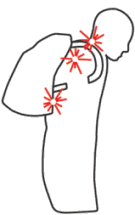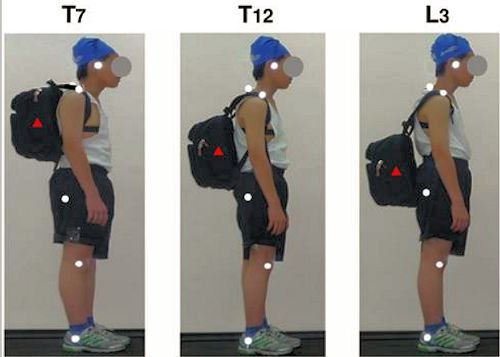Backpacks: How To Locate & Correct Problems Causing Pain & Poor Posture
Backpacks used by kids are causing problems. It tends to involve the entire spine, however, the upper back is vulnerable, especially when the spine is still developing. Upper back pain and related spinal issues with posture ensues due to some basic problems with kids using school bags.
A series of stages progresses with kids at school age; growth spurts, development of balance and coordination, and postural stability. With overloaded school bags, asymmetry of the backpack straps and poor location, reduction of physical activity, increased body weight, and increased use of electronic devices have negative side effects like postural dysfunction that can lead to immediate symptoms and future consequences.
- We know from a 2017 study in BMC Musculoskeletal Disorders that parental control is paramount to prevention, however, there is a role to be played by school system educators directly involved as well.
Three Factors Related To Improper Use Of Back Packs:
- Asymmetric Strap Length: The study found this caused increased incidence of body rotation that exceeding normal levels. 83.8% of girls and 75.9% of boys had the straps adjusted to different lengths. This rotation places enormous stress on the spine and its relates structures, including the discs, and will tend to cause a scoliosis type of postural distortion.
- Bookbags Placed Too High On The Spine: This directly impacts the upper back and the study found increased upper thoracic curvature (kyphosis) in 77.9% of girls and in 62.8% of boys. Increased kyphosis lead to a hunched over posture typically seen in older adults. This also affects the lower back or lumbar spine as well. Combined with asymmetrical straps and this is a recipe for scoliosis and possible chronic pain into adult life.
- Too Much Weight: The correct weight should be about 10% of body weight, no more than 15%. This means if the weight is 100 pounds, no more than 15 pounds of backpack weight. Overloading the spine accentuates the above tow factors as well as stresses muscular and postural compensation. In the study, school bags were heavier than the recommendation in 79% of boys and in 64% of girls.
 Backpacks were most noted to be placed too high, which is compensated by leaning forward, which overloads the spines, and this is subsequently compensated by a deformation in thoracic, lumbar and cervical postural angles that can lead to upper back as well as neck and lower back pain.
Backpacks were most noted to be placed too high, which is compensated by leaning forward, which overloads the spines, and this is subsequently compensated by a deformation in thoracic, lumbar and cervical postural angles that can lead to upper back as well as neck and lower back pain.
With an increase in the thoracic angle, the typical compensation is head forward with upper cervical extension and lower cervical flexion to maintain level eye gaze. The lumbar spine curve is reduced and the sacrum straightens. From a biomechanical viewpoint coupled with spinal maturation and musculoskeletal development, this is quite concerning.
Excessive backpack loading is related to back pain as well as and spinal problems. “Backpack Syndrome” has been described as altered body posture causing neck and back pain, fatigue, and headaches. Asymmetric loading can effect spinal discs, which may lead degenerative changes in the spine over time.
“Backpack Palsy” is a condition that has been reported where nerve injury is caused from traction of the shoulder straps. This can cause numbness, pain and weakness of the shoulders, arms and hands. The area of damage is the brachial plexus where the nerves exit the cervical spine and go down the arm often seen in cervical radiculopathy or a pinched nerve.
- A 2008 study in the Journal of Pediatric Orthopedics found that too high or too low positioning of schoolbags produced enough pressure to cut off blood flow, even at 10% of bodyweight. The authors indicated that asymmetric and high pressures for extended periods help explain shoulder problems and back pain attributed to backpacks.
- A 2004 study in the Journal of Spinal Disorders & Techniques found that thoracic spine pain as well as back pain increased with increasing backpack weight. They found girls were more prone to this than boys and shorter kids were more prone to pain than taller kids.
- A 2004 study in the Journal of Pediatric Orthopedics found in 3,498 school students, over 41% indicated pain when carrying school bags, almost 17% consulted doctors for related pain and about 16% missed school activity due to backpack pain.
- A 2018 study in the journal PLoS One studied the effects of back pack weight and positioning on boys and the effects of walking on a treadmill. The authors recommend a backpack weight of no more than 10% and a positioning of the center of the bag (red arrows) at the T12 position (middle) to minimize stress of all posture metrics studied (white dots).

While more studies are needed to confirm particular data, parents as well as teachers must be engaged. A consequence that is easily observed is forward head posture.
Three Measures To Correct Improper Use Of School Backpacks
- Measure – Length Of Straps Should Be Equal
- Weigh – Know The Weight Recommendations: Backpack Weight/Student Weight (10-15%)
- Observe – Observe Posture With Backpack On: Middle Of Backpack Around T12 (Middle Bag At Middle Back)
Pack only necessary things for a particular day. Become familiar with postural positioning and ergonomic behavior. Communication and cooperation between parents, students, and school administration can be helpful. Leaving heavy books and notebooks at school would as well as easier access to lockers and a shift to electronic means will be beneficial in reducing the burden put on our children’s spine.

Most of the young patients I would see referred from a school scoliosis screening test were from concerned parents, especially in those students with musculoskeletal symptoms. Most of the complaints were upper back pain, and this is usually the first sign something is not right. The weak point seems to be the shoulders and subsequent spinal reactions. Rarely was it due to a structural or genetic problem, rather it was due to improper backpack use from one or all of the three factors.
Careful instruction along with minimal care was usually needed. Children with related upper back pain would tend to respond well to adjustments, a brief mirror image back pack use for a period of correction with asymmetrical school bags straps may help. Then conforming to basic standards of use, modified individually for best results.
Backpacks that are old and worn should be replaced. While some are better than others, typical use by kids finds them withstanding all kinds of use and abuse. Straps can stretch and tear leading to asymmetry even with proper measurement. Weakness in areas can shift loading to one side. Frequent examination for signs of uneven wear is important.
Putting on and taking off school bags are not as much of a concern when the weight is calculated correctly. This is not a camping trip that is done once in a while, this is something done everyday and as the weight approximates recommendations, using it naturally becomes easier and less damaging. General rules of lifting apply; bend knees and keep bag close to body.
Parents should make sure that their kids backpacks contains no loose strings, dangling cords, or anything that can catch while walking, like in the school bus door or make them trip or fall.
- A 2020 study in the International Journal of Environmental Research and Public Health found an association between using a backpack and the risk of developing foot pronation. Excessive pronation can lead to degenerative and chronic pain in the knees, hips and back.
Keep It Lightweight
- A 2019 study in the International Journal of Adolescent Medicine and Health found that even a bag weighing less than 10% of body weight caused biomechanical changes in neck and shoulder posture during the activities that a child perform with a school bag when standing, as well as during and after walking. So, the recommended weight for bags may be trending downward.
- A 2020 study in the journal Work studied the effects of just a 5% body mass load on 150 young adults. They noticed significant changes in of craniovertebral posture of the head and neck. This is involved in neck pain conditions and forward head posture. The authors of the study concluded, “Changes in the horizontal position of a fixed load affect external measures of craniovertebral posture so consideration needs to be given to not only the weight of a backpack but how the weight is positioned within the backpack.”
What About Shoulder Bags?
- A 2020 study in Acta Biomedica found that 10% bodyweight carried on one shoulder (asymmetrical condition) caused a postural alteration resulting in altered swing phase during gait as well as pelvic tilting associated with lower back pain, compared to both shoulders.


